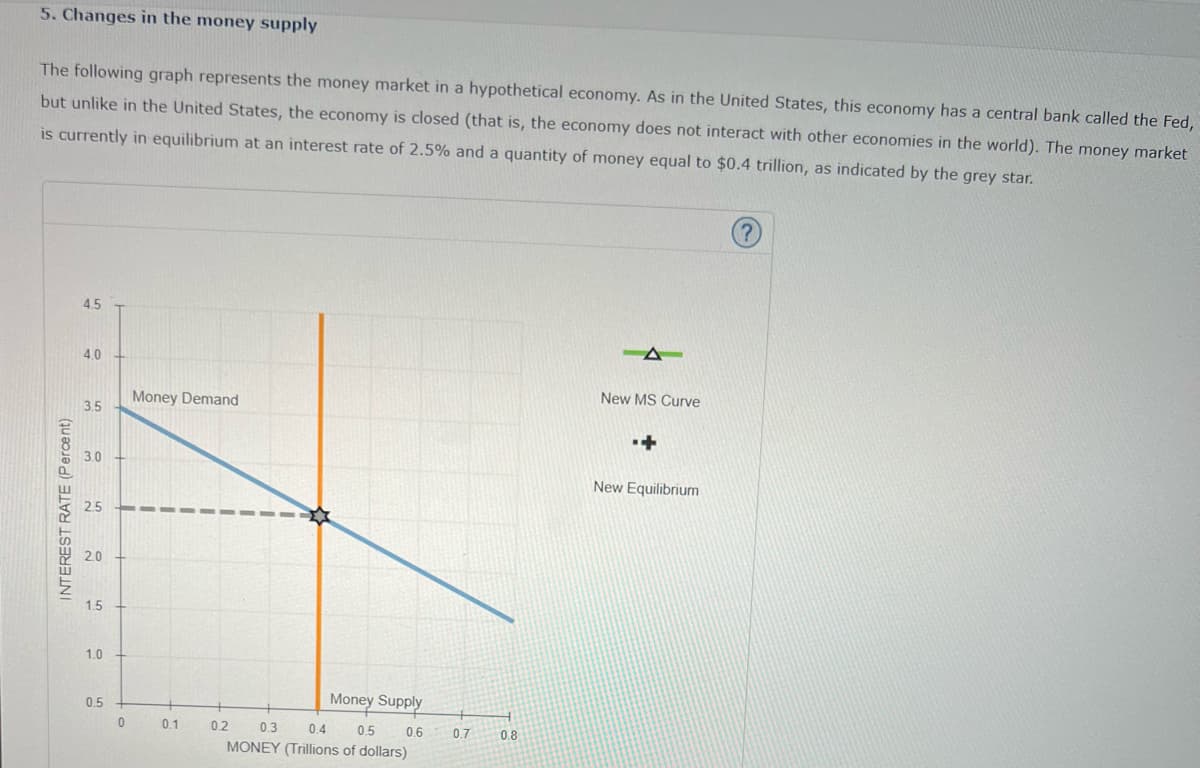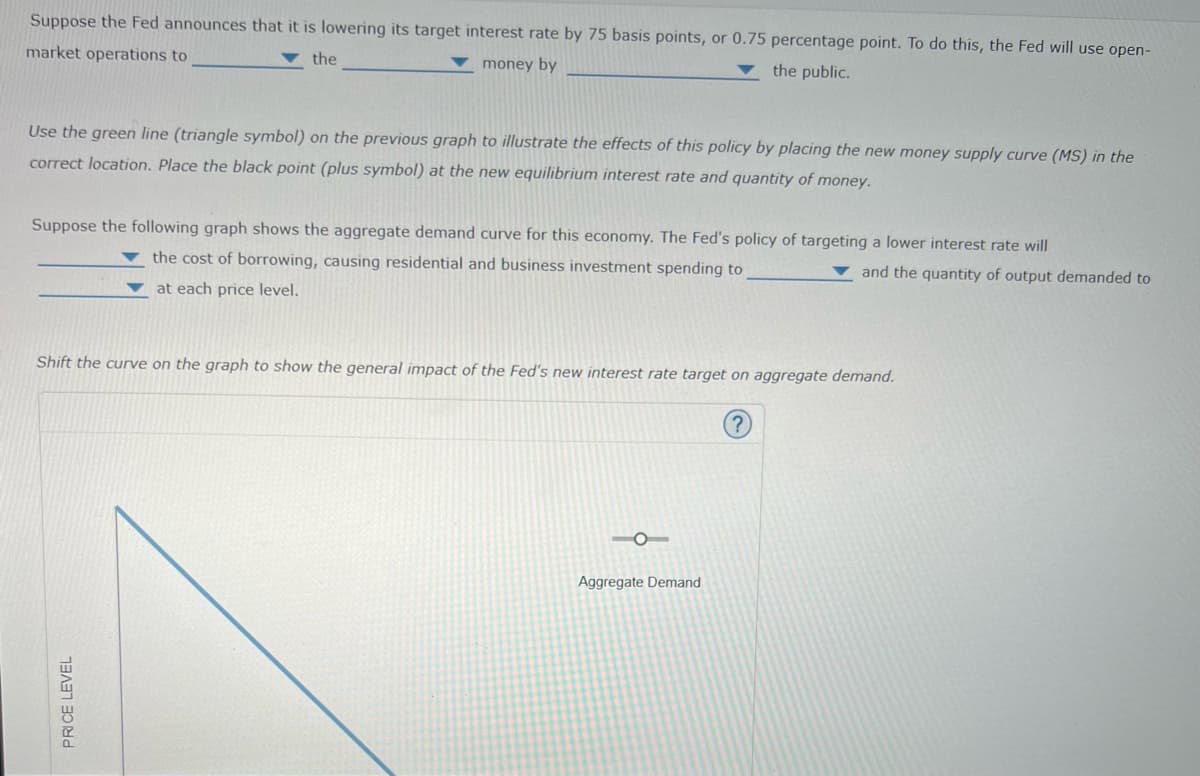5. Changes in the money supply The following graph represents the money market in a hypothetical economy. As in the United States, this economy has a central bank called the Fed, but unlike in the United States, the economy is closed (that is, the economy does not interact with other economies in the world). The money market is currently in equilibrium at an interest rate of 2.5% and a quantity of money equal to $0.4 trillion, as indicated by the grey star. 45 4.0 New MS Curve Money Demand + New Equilibrium INTEREST RATE (Percent) 3.5 2.5 2.0 1.5 1.0 0.5 0 0.1 Money Supply 0.2 0.3 0.4 0.5 0.6 MONEY (Trillions of dollars) 0.7 0.8
5. Changes in the money supply The following graph represents the money market in a hypothetical economy. As in the United States, this economy has a central bank called the Fed, but unlike in the United States, the economy is closed (that is, the economy does not interact with other economies in the world). The money market is currently in equilibrium at an interest rate of 2.5% and a quantity of money equal to $0.4 trillion, as indicated by the grey star. 45 4.0 New MS Curve Money Demand + New Equilibrium INTEREST RATE (Percent) 3.5 2.5 2.0 1.5 1.0 0.5 0 0.1 Money Supply 0.2 0.3 0.4 0.5 0.6 MONEY (Trillions of dollars) 0.7 0.8
Brief Principles of Macroeconomics (MindTap Course List)
8th Edition
ISBN:9781337091985
Author:N. Gregory Mankiw
Publisher:N. Gregory Mankiw
Chapter11: The Monetary System
Section: Chapter Questions
Problem 5CQQ
Related questions
Question
100%

Transcribed Image Text:5. Changes in the money supply
The following graph represents the money market in a hypothetical economy. As in the United States, this economy has a central bank called the Fed,
but unlike in the United States, the economy is closed (that is, the economy does not interact with other economies in the world). The money market
is currently in equilibrium at an interest rate of 2.5% and a quantity of money equal to $0.4 trillion, as indicated by the grey star.
45
Money Demand
New MS Curve
+
New Equilibrium
4.0
3.5
3.0
2.5
2.0
INTEREST RATE (Percent)
55555
1.5
1.0
0.5
0
0.1
Money Supply
0.2
0.3 0.4 0.5 0.6
MONEY (Trillions of dollars)
0.7 0.8

Transcribed Image Text:Suppose the Fed announces that it is lowering its target interest rate by 75 basis points, or 0.75 percentage point. To do this, the Fed will use open-
market operations to
the
money by
the public.
Use the green line (triangle symbol) on the previous graph to illustrate the effects of this policy by placing the new money supply curve (MS) in the
correct location. Place the black point (plus symbol) at the new equilibrium interest rate and quantity of money.
Suppose the following graph shows the aggregate demand curve for this economy. The Fed's policy of targeting a lower interest rate will
the cost of borrowing, causing residential and business investment spending to
and the quantity of output demanded to
at each price level.
Shift the curve on the graph to show the general impact of the Fed's new interest rate target on aggregate demand.
Aggregate Demand
PRICE LEVEL
Expert Solution
This question has been solved!
Explore an expertly crafted, step-by-step solution for a thorough understanding of key concepts.
This is a popular solution!
Trending now
This is a popular solution!
Step by step
Solved in 3 steps with 1 images

Knowledge Booster
Learn more about
Need a deep-dive on the concept behind this application? Look no further. Learn more about this topic, economics and related others by exploring similar questions and additional content below.Recommended textbooks for you

Brief Principles of Macroeconomics (MindTap Cours…
Economics
ISBN:
9781337091985
Author:
N. Gregory Mankiw
Publisher:
Cengage Learning

Essentials of Economics (MindTap Course List)
Economics
ISBN:
9781337091992
Author:
N. Gregory Mankiw
Publisher:
Cengage Learning

Principles of Economics (MindTap Course List)
Economics
ISBN:
9781305585126
Author:
N. Gregory Mankiw
Publisher:
Cengage Learning

Brief Principles of Macroeconomics (MindTap Cours…
Economics
ISBN:
9781337091985
Author:
N. Gregory Mankiw
Publisher:
Cengage Learning

Essentials of Economics (MindTap Course List)
Economics
ISBN:
9781337091992
Author:
N. Gregory Mankiw
Publisher:
Cengage Learning

Principles of Economics (MindTap Course List)
Economics
ISBN:
9781305585126
Author:
N. Gregory Mankiw
Publisher:
Cengage Learning

Principles of Macroeconomics (MindTap Course List)
Economics
ISBN:
9781285165912
Author:
N. Gregory Mankiw
Publisher:
Cengage Learning

Principles of Economics, 7th Edition (MindTap Cou…
Economics
ISBN:
9781285165875
Author:
N. Gregory Mankiw
Publisher:
Cengage Learning

Principles of Macroeconomics (MindTap Course List)
Economics
ISBN:
9781305971509
Author:
N. Gregory Mankiw
Publisher:
Cengage Learning